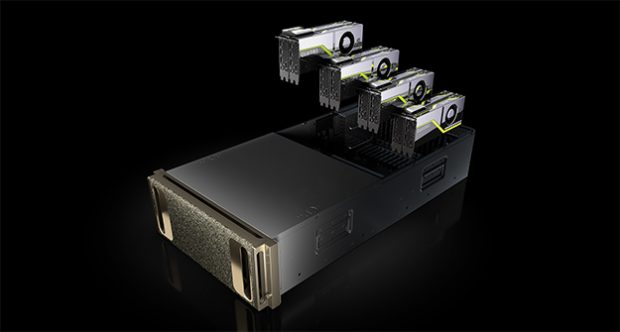NVIDIA Unveils New GPU Architecture
Latest News
August 14, 2018
NVIDIA announces a computer graphics transformation with the launch of its NVIDIA Turing GPU architecture. NVIDIA made the announcement at SIGGRAPH, which takes place Aug. 12-16, 2018, in Vancouver, Canada.
Turing features new RT Cores to accelerate ray tracing and new Tensor Cores for artificial intelligence (AI) inferencing that make real-time ray tracing possible, according to NVIDIA.
“Turing is NVIDIA’s most important innovation in computer graphics in more than a decade.”
These two engines open up a new generation of hybrid rendering to target the visual effects industry. Hybrid rendering enables cinematic-quality interactive experiences, new effects powered by neural networks and fluid interactivity on complex models.
The company also unveiled its initial Turing-based products—the NVIDIA Quadro RTX 8000, Quadro RTX 6000 and Quadro RTX 5000 GPUs.
“Turing is NVIDIA’s most important innovation in computer graphics in more than a decade,” says Jensen Huang, founder and CEO of NVIDIA, speaking at the start of the annual SIGGRAPH conference. “Hybrid rendering will change the industry, opening up amazing possibilities that enhance our lives with more beautiful designs, richer entertainment and more interactive experiences. The arrival of real-time ray tracing is the Holy Grail of our industry.”
NVIDIA’s eighth-generation GPU architecture, Turing enables a ray-tracing GPU. By using Turing’s hybrid rendering capabilities, applications can simulate the physical world at a much faster speed than the previous Pascal generation. NVIDIA has enhanced its RTX development platform with new AI, ray tracing and simulation software development kits.
The Turing architecture has dedicated ray-tracing processors called RT Cores, which accelerate the computation of how light and sound travel in 3D environments at up to 10 GigaRays a second. Turing accelerates real-time ray tracing operations.
AI Accelerated by Tensor Cores
The Turing architecture also features Tensor Cores, processors that accelerate deep learning training and inferencing, providing up to 500 trillion tensor operations a second.
https://twitter.com/DEeditor/status/1029159923102507009
This performance powers AI-enhanced features for creating applications with new capabilities, such as deep learning anti-aliasing, entailing motion image generation—denoising, resolution scaling and video retiming.
These features are part of the NVIDIA NGX software development kit, a new deep learning-powered technology stack that enables easy integration of accelerated, enhanced graphics, photo imaging and video processing into applications with pretrained networks.
Faster Simulation and Rasterization
Turing-based GPUs feature a new streaming multiprocessor (SM) architecture that adds an integer execution unit executing in parallel with the floating point datapath, and a new unified cache architecture with double the bandwidth of the previous generation.
The Turing SM is combined with new graphics technologies such as variable rate shading. With up to 4,608 CUDA cores, Turing supports up to 16 trillion floating point operations in parallel with 16 trillion integer operations per second.
Developers can use NVIDIA’s CUDA 10, FleX and PhysX SDKs to create complex simulations, such as particles or fluid dynamics for scientific visualization, virtual environments and special effects.
Availability
Quadro GPUs based on Turing will be initially available in the fourth quarter.
In related news, NVIDIA also unveils Quadro RTX, a ray-tracing GPU. This can enabledesigners and artists to render photorealistic scenes in real time, add new AI-based capabilities to their workflows and experience fluid interactivity with complex models and scenes.
Unveiled by Huang at the SIGGRAPH conference, the NVIDIA Quadro RTX 8000, Quadro RTX 6000 and Quadro RTX 5000 bring hardware-accelerated ray tracing, AI, advanced shading and simulation to professionals. Also announced was the Quadro RTX Server, a reference architecture for highly configurable, on-demand rendering and virtual workstation solutions from the datacenter.
“Quadro RTX marks the launch of a new era for the global computer graphics industry,” says Bob Pette, vice president of Professional Visualization at NVIDIA. “Users can now enjoy powerful capabilities that weren’t expected to be available for at least five more years. Designers and artists can interact in real time with their complex designs and visual effects in ray-traced photo-realistic detail.”
Quadro RTX Professional GPUs
Quadro RTX GPUs are designed for visual computing workloads, such as those used in automotive and architectural design; and scientific visualization. New technologies include:
- new RT Cores to enable real-time ray tracing of objects and environments with physically accurate shadows, reflections, refractions and global illumination;
- Turing Tensor Cores to accelerate deep neural network training and inference;
- new Turing Streaming Multiprocessor architecture, featuring up to 4,608 CUDA cores;
- advanced programmable shading technologies to improve the performance of complex visual effects;
- first implementation of ultra-fast Samsung 16Gb GDDR6 memory to support complex designs;
- NVIDIA NVLink to combine two GPUs with a high-speed link to scale memory capacity up to 96GB and drive higher performance with up to 100GB/s of data transfer;
- hardware support for USB Type-C and VirtualLink, a new open industry standard being developed to meet the power, display and bandwidth demands of next-generation VR headsets through a single USB-C connector; and
- new and enhanced technologies to improve performance of VR applications.
Quadro RTX Server
The Quadro RTX Server enables easy configuration of on-demand render nodes for batch and interactive rendering. It combines Quadro RTX GPUs with new Quadro Infinity software (available in the first quarter of 2019) to deliver flexible architecture. Quadro Infinity will enable multiple users to access a single GPU through virtual workstations. End-users can also easily provision render nodes and workstations based on specific needs.
https://twitter.com/DEeditor/status/1029156948749496323
Pricing
- Quadro RTX 8000 with 48GB memory: $10,000 estimated street price
- Quadro RTX 6000 with 24GB memory: $6,300 ESP
- Quadro RTX 5000 with 16GB memory: $2,300 ESP
Availability
Quadro RTX GPUs will be available starting in the fourth quarter.
For more info, visit NVIDIA.
Sources: Press materials received from the company.
Subscribe to our FREE magazine, FREE email newsletters or both!
Latest News
About the Author
DE’s editors contribute news and new product announcements to Digital Engineering.
Press releases may be sent to them via [email protected].







 NVIDIA Quadro RTX Server. Image courtesy of NVIDIA.
NVIDIA Quadro RTX Server. Image courtesy of NVIDIA.